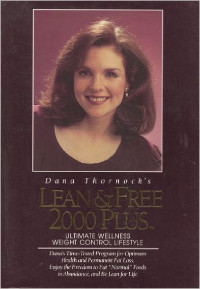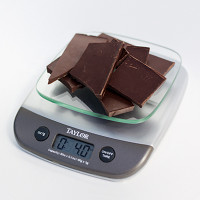I’m deviating from my normal blogging style for several months to share brief information about books that have significantly helped me obtain better health.
To read the first post in this series, “Books that Helped Me Lose 100 Pounds, Part 1: Introduction,” please click here.
Disclaimer: I’m not a doctor or a dietitian. I do not recommend or endorse a particular health regimen. My intention is to provide a few insights into what has worked for me at various times of my life. The information in these posts is no substitute for individual medical advice, and you use it at your own risk. These books, in the end, were not even enough for me. I lost the final 40 pounds by working with a registered dietitian. I’ll tell you more about that in the fourth post of this series.
I didn’t discover the next book on my list until the year 2000.

Dana Thornock’s Lean & Free 2000 Plus, by Dana Thornock © 1994
“Eating well above 2000 delicious, normal calories a day, Dana dropped from 204 pounds and a size 18 to a size 4. . . . She has read virtually every reputable book, article, and program about nutrition, wellness, and weight control. . . . Unlike diets, the Lean and Free 2000 Plus program doesn’t deprive, it provides! You’ll be free to enjoy favorite foods. But most of all, you will experience a life unhampered by the worry of excess body fat or ever getting fat again.”
While you’re in a life-and-death struggle with your own body, it’s impossible to find complete contentment or joy. (p. 103)
In this program you will reverse everything you’ve been told about losing weight. You won’t diet your way to an unhealthy, starved body. You will eat your way to health. . . . You’ll look great, you’ll feel great, and you’ll have the abundant vigor that frees you to be of service to all around you. (p. 4)
Dana Thornock’s dietary advice—with its emphasis on complex carbohydrates such as vegetables, whole grains, and fruit—is similar to that recommended by the authors of How to Lower Your Fat Thermostat, which I told you about in my last post. Her program, however, addresses lifestyle issues in a more comprehensive way, such as motivation, goal-setting, daily meal-planning, eating out, and managing healthy eating when the family is resistant to the changes. The macronutrient ratio of her plan is 65–80% carbohydrate, 10–15% protein, and 10–20% fat. She recommends limiting added sugar to no more than 5% of total calories, although she recognizes that many people don’t have bodies that are “resistant to fat loss” and can lose weight quite well without eliminating sugar. I fell into that category at the time, so I never felt a need to restrict sugar too much, as long as I balanced my other food choices in the way she suggests.
Dana Thornock, like the authors of How to Lower Your Fat Thermostat, recommends an hour of aerobic exercise a day for fat loss, along with other exercises. During this period of my weight-loss journey, I was never able to progress past the aerobic aspect of the fitness advice. I began with walking on a level surface for 7 minutes, pushing a child in a stroller, which, at the time, was quite strenuous for me. I built it up to 45 minutes a day, several days a week.
Dana Thornock’s Lean & Free 2000 Plus is one of only two books on my list that addresses the issue of caffeine addiction:
It is cola caffeine, not coffee, that is the number-one addiction in many people’s lives. I’ve seen people lose two inches around their waistlines in one week when they’ve eliminated colas from their lives. (p.28)
When I began using this book, I didn’t drink coffee, tea, cola, or any soft drink with caffeine in it, but I did have a problem with chocolate. I regularly ate huge amounts of chocolate—4 ounces at a time and sometimes even more. Even when I worked to lower the fat in my baked goods, I altered cake and brownie recipes to contain more cocoa. Rarely a day went by when I didn’t have chocolate in some form, and when I had a chocolate craving, it could only be satisfied by eating chocolate, not pumpkin pie, and it had to be rich chocolate. I knew this was unhealthy and was able to minimize my chocolate use from time to time, but I always went back to it when I was tired or stressed.

Early in 2003, when I was at my highest weight and desperate to find the motivation to stay with a healthy eating and exercise program for more than a month at a time, I finally confronted my problem with chocolate. I did some research and learned that chocolate not only contains caffeine but other chemicals as well, such as theobromine and theophylline. Theobromine isn’t as strong a stimulant as caffeine, but there is considerably more of it than caffeine in chocolate. I also forced myself to accept the fact that this chemical craving, which had been instrumental in making me 100 pounds overweight, was not a harmless addiction. This discovery, as difficult as it was, gave me a strong feeling of hope, because I finally understood that it wasn’t lack of self-discipline that urged me toward chocolate; chocolate was sapping my self-discipline. I knew, deep in my heart, that I would never get control of my weight, and subsequently my health, while I had this particular craving, but I saw a way to throw off its chains—I stopped eating chocolate.
That said, I have no desire to suggest that everyone or even anyone stop eating chocolate! I had a real problem with it, which I hesitated to address at all in this series of posts. I believe that moderation is an important component in a healthy diet, and the idea of chocolate addiction really does sound extreme and absurd. I decided to go ahead and tell you about my experience with chocolate for three reasons: 1. Chocolate addiction is so minimized these days that anyone who reads this post is unlikely to find much information anywhere else that puts this kind of serious, yet necessary, spin on it. 2. After I gave it up, I felt so much better! Once my body adjusted, I stopped having what I believe were withdrawal headaches. I experienced these every time I attempted to minimize my chocolate consumption. 3. Giving up the chocolate habit was the major turning point in my health quest. Once I resolved that issue, I was in a much better position both physically and mentally to address the other issues that contributed to my obesity. I stopped gaining weight and started losing it by following Dana Thornock’s program—albeit in a sporadic way. Between 2003 and 2005 I lost 20 pounds and kept it off.
The photo of 4 oz. Semi-Sweet Chocolate is credited to Novaun Novels and licensed as follows:
This work by Novaun Novels is licensed under a Creative Commons Attribution-ShareAlike 4.0 International License.
The featured image came from Pixabay.




